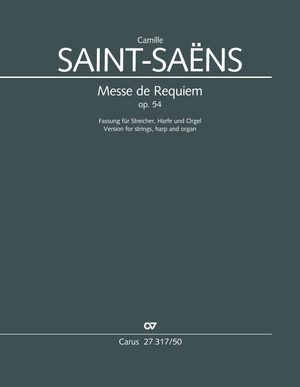
Messe de Requiem
Arrangement for strings, harp and organ (arr. K. Rothaupt) op. 54, 1878/2020
Saint-Saëns’ colorful Messe de Requiem op. 54, originally opulently scored, is published here in an ingenious reduced version, so that smaller choirs, and choirs with more limited resources of space or finance can also perform this attractive work with smaller instrumental forces.
The original large forces – quadruple wind and brass and four harps – may have been a reason why the expressive and richly colored work was less well-known than the composer’s Oratorio de Noël (Carus 40.455), a popular work the world over. To expand the options for performance, Carus has therefore published two versions of the Messe de Requiem – the original version, whose material has been arranged in such a way that the work can alternatively be performed with 11 instead of 20 wind and brass instruments (Carus 27.317), and a version without any wind or brass, scored just for strings, one or two harps, and organ. These versions are based on an arrangement published by Durand in 1927, and newly adapted by Klaus Rothaupt. The organ is allocated sections of the original wind and brass parts; registration details will help rehearsing. The vocal and string parts are unaltered compared with the original composition, so the vocal and choral score of the original version can also be used for this version. This is a fine-sounding, distinctive setting of the Requiem Mass which is undoubtedly one of the composer’s most important works.
- Major requiem can also be performed by smaller choir
- version without any wind or brass, reduced strings, one or two harps, and organ
- Vocal scores and choral scores from the original version can be used.
| Original version | Arrangement for strings, harp and organ |
| Soli SATB, Coro SATB, 4 Fl, 2 Ob, 2 Eh, 4 Fg, 4 Cor, 4 Trb, 4 Arpa, Grand Orgue, Orgue d’accompagnement, 2 Vl, Va, Vc, Cb (reduzierte Fassung: 2 Fl, 2 Ob, 2 Eh, 2 Fg, 2 Cor, Trb, 2 Arpa, Org, 2 Vl, Va, Vc, Cb) | Soli SATB, Coro SATB, 2 (1) Arpa, 2 Vl, Va, Vc, Cb, Org |
-
Composer
Camille Saint-Saëns
| 1835-1921Camille Saint-Saëns war ein wahres Multitalent. Er war Pianist, Dirigent, Organist, Musikwissenschaftler, Musikpädagoge und Komponist und erlangte vor allem durch den Karneval der Tiere und die Oper Samson et Dalila Bekanntheit.
Seine Sinfonie A-Dur komponierte er mit 15 und wurde bereits mit 16 an der Universität in Paris aufgenommen. Klavier, Orgel und Komposition studierte Saint-Saëns am Pariser Konservatorium und wurde 1852 Organist von Saint-Séverin in Paris. Im selben Jahr lernte er auch Franz Liszt kennen, welcher folgend einen Einfluss auf Saint-Saëns kompositorisches Schaffen ausübte. Ein Jahr später feierte er dann als Komponist sein musikalisches Debüt. Die Oper Samson et Dalila, die 1877 in Weimar uraufgeführt wurde, brachte ihm einen bis heute anhaltenden Erfolg an den Opernhäusern. Sein Weihnachtsoratorium Oratorio de Noël, das beim Carus-Verlag erhältlich ist, ist wohl das bekannteste seiner geistlichen Werke. Personal details
-
Arranger
Klaus Rothaupt
Frequent questions about this work
 There are no questions and answers available so far or you were unable to find an answer to your specific question about this work? Then click here and send your specific questions to our Customer Services!
There are no questions and answers available so far or you were unable to find an answer to your specific question about this work? Then click here and send your specific questions to our Customer Services!


